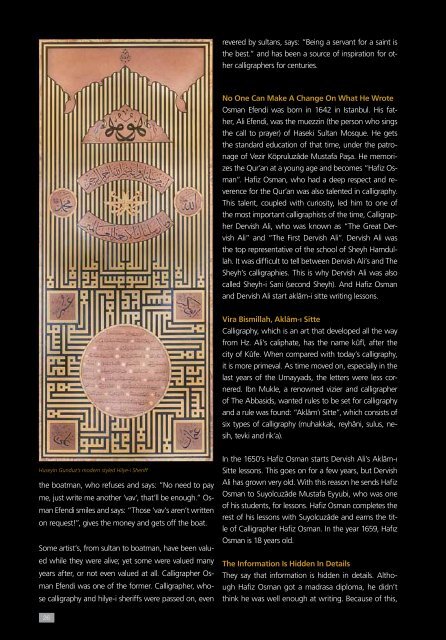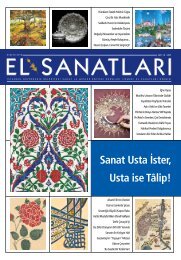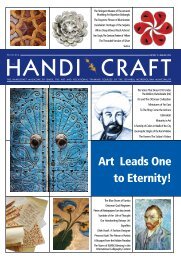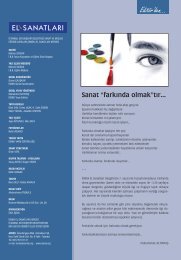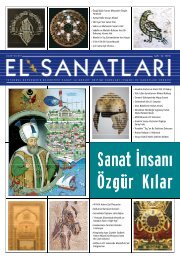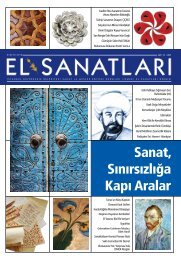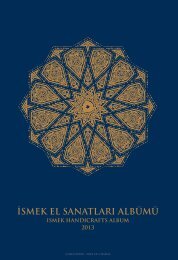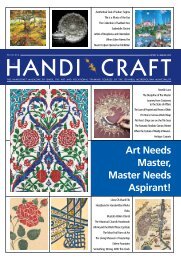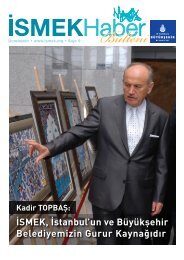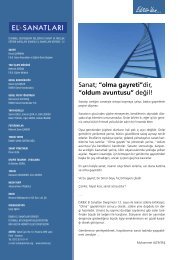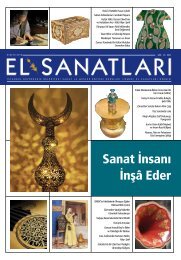Download Link - Ä°SMEK
Download Link - Ä°SMEK
Download Link - Ä°SMEK
Create successful ePaper yourself
Turn your PDF publications into a flip-book with our unique Google optimized e-Paper software.
evered by sultans, says: “Being a servant for a saint is<br />
the best.” and has been a source of inspiration for other<br />
calligraphers for centuries.<br />
No One Can Make A Change On What He Wrote<br />
Osman Efendi was born in 1642 in Istanbul. His father,<br />
Ali Efendi, was the muezzin (the person who sings<br />
the call to prayer) of Haseki Sultan Mosque. He gets<br />
the standard education of that time, under the patronage<br />
of Vezir Köpruluzâde Mustafa Paşa. He memorizes<br />
the Qur’an at a young age and becomes “Hafiz Osman”.<br />
Hafiz Osman, who had a deep respect and reverence<br />
for the Qur’an was also talented in calligraphy.<br />
This talent, coupled with curiosity, led him to one of<br />
the most important calligraphists of the time, Calligrapher<br />
Dervish Ali, who was known as “The Great Dervish<br />
Ali” and “The First Dervish Ali”. Dervish Ali was<br />
the top representative of the school of Sheyh Hamdullah.<br />
It was difficult to tell between Dervish Ali’s and The<br />
Sheyh’s calligraphies. This is why Dervish Ali was also<br />
called Sheyh-i Sani (second Sheyh). And Hafiz Osman<br />
and Dervish Ali start aklâm-i sitte writing lessons.<br />
Vira Bismillah, Aklâm-ı Sitte<br />
Calligraphy, which is an art that developed all the way<br />
from Hz. Ali’s caliphate, has the name kûfî, after the<br />
city of Kûfe. When compared with today’s calligraphy,<br />
it is more primeval. As time moved on, especially in the<br />
last years of the Umayyads, the letters were less cornered.<br />
Ibn Mukle, a renowned vizier and calligrapher<br />
of The Abbasids, wanted rules to be set for calligraphy<br />
and a rule was found: “Aklâm’ı Sitte”, which consists of<br />
six types of calligraphy (muhakkak, reyhâni, sulus, nesih,<br />
tevki and rik’a).<br />
Huseyin Gunduz’s modern styled Hilye-i Sheriff<br />
the boatman, who refuses and says: “No need to pay<br />
me, just write me another ‘vav’, that’ll be enough.” Osman<br />
Efendi smiles and says: “Those ‘vav’s aren’t written<br />
on request!”, gives the money and gets off the boat.<br />
Some artist’s, from sultan to boatman, have been valued<br />
while they were alive; yet some were valued many<br />
years after, or not even valued at all. Calligrapher Osman<br />
Efendi was one of the former. Calligrapher, whose<br />
calligraphy and hilye-i sheriffs were passed on, even<br />
In the 1650’s Hafiz Osman starts Dervish Ali’s Aklâm-ı<br />
Sitte lessons. This goes on for a few years, but Dervish<br />
Ali has grown very old. With this reason he sends Hafiz<br />
Osman to Suyolcuzâde Mustafa Eyyubi, who was one<br />
of his students, for lessons. Hafiz Osman completes the<br />
rest of his lessons with Suyolcuzâde and earns the title<br />
of Calligrapher Hafiz Osman. In the year 1659, Hafız<br />
Osman is 18 years old.<br />
The Information Is Hidden In Details<br />
They say that information is hidden in details. Although<br />
Hafiz Osman got a madrasa diploma, he didn’t<br />
think he was well enough at writing. Because of this,<br />
26


